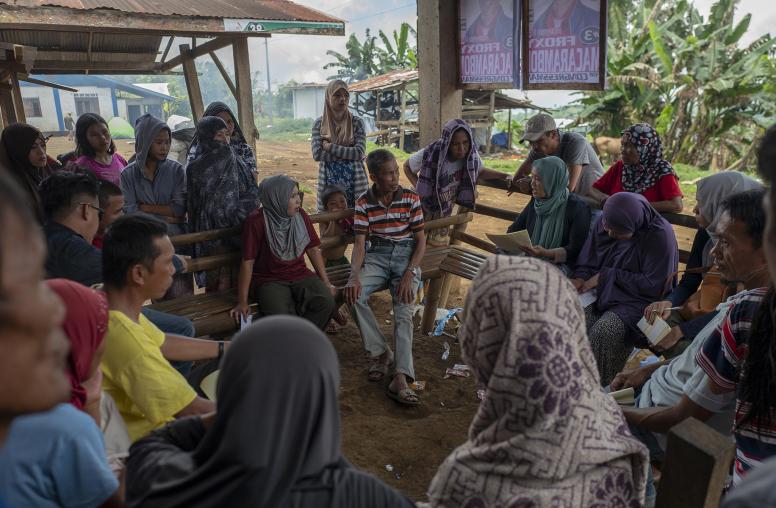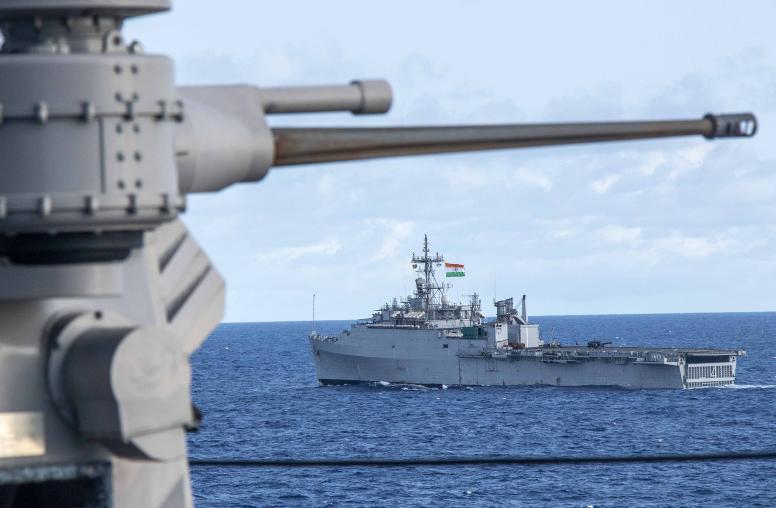Far From the Madding Crowd
Can ordinary citizens armed with technology change the way we make and manage peace?
On Saturday, Nov. 23, for the third evening in a row, the website Aymta.com sent a text message and e-mail blast to its subscribers, saying that a scud missile had been launched from Damascus, on its way to the northern Syrian city of Ar-Raqqah. Residents there had about ten minutes to shelter themselves however they could.

Aymta.com, designed by a 27-year-old software designer and former Syrian army conscript who is now in the United States, is an open-sourced warning system that relies on the reporting of volunteer spotters -- that is, ordinary citizens -- and a series of formulas that calculate a missile's trajectory and probable target. When it's locked on the probable destination, the site (the name of which means "when" in Arabic) automatically sends information to subscribers as a warning.
The site doesn't catch every launch, and it's hard to tell just how accurate its predictions are -- but it's something. And it exemplifies how people are using technology to save lives in war zones.
Pundits and researchers alike have focused recently on the role of technology in social-media-fueled political and social change movements, with headlines proclaiming a "Twitter Revolution" in Iran's 2009 election protests and "Facebook Revolutions" in the Tunisian and Egyptian overthrow of entrenched regimes. And the Syrian conflict is the most socially and technologically mediated conflict in history, according to experts, with an exceptional amount of what the outside world knows -- or thinks it knows -- about the three-year-old war coming from videos, blogs, and commentary circulated through social networks.
But this is only part of the new story of technology and conflict. "Crowdsourcing" is the other part. The term, which refers to the practice of soliciting services, ideas, or content from a large group, often online, was coined in 2006 (according to the world's first crowdsourced dictionary, Wikipedia). Yet it has already taken on several important functions with respect to the peacebuilding field.
First, the crowd, as we saw in the Syrian example, is helping us get data and information from conflict zones. Until recently these regions were dominated by "the fog war," which blinded journalists and civilians alike; it took the most intrepid reporters to get any information on what was happening on the ground. But in the past few years, technology has turned conflict zones from data vacuums into data troves, making it possible to render parts the conflict in real time.
Activists, citizen journalists, and ordinary folks armed with mobile phones and social networks, have come together to create real-time crisis maps and documentation of violence as it happens.
One of the early examples of this was the Libya Crisis Map -- a crowdsourced map of events unfolding throughout the rebellion that was commissioned by the U.N. -- which was put together by a loosely affiliated but committed global group of volunteer techies, called the Standby Taskforce. By sifting through social media, news reports, YouTube postings, and blogs for verifiable data, they were able to assemble a valuable picture of the unfolding crisis. They mapped where armed confrontations, humanitarian relief efforts, and other relevant activities were taking place. In Syria, a parallel effort led to the Defections Map, chronicling members of the regime who had defected based upon information from networks of activists and video announcements on YouTube. These defections were then widely reported in the offline media, such as Al Jazeera and others.
The second way technology has changed the business of peace is dollars. In the same way that entrepreneurs and young filmmakers are using sites like Kickstarter and Indiegogo to fund their work, so are peacebuilders. For example, Bilal Ghalib, an Iraqi-American web developer, and Mitch Altman, co-founder of Noisebridge, one of the first hacker-community workspaces in the United States, turned to Kickstarter to bring community "hackerspaces" to Baghdad. They funded tools, computers, and lounges to recreate a temporary Silicon Valley-esque atmosphere where tech geeks and entrepreneurs can collaborate and work on innovative, open-source projects -- and, in turn, create jobs for young people trying to rebuild their post conflict economies. Bilal and Mitch raised almost $30,000 to bring a community hackerspace to Baghdad, in addition to the five they have started in Egypt and two in Lebanon.
We hear stories like this all the time, where the crowd is both funder and peacebuilder, as in the Indiegogo campaign that raised enough money to enable a group of young volunteer tech activists called "PeaceGeeks" to work with grassroots organizations in conflict zones to promote peace, or HarrassMap in Cairo, which tracks and maps reports of sexual harassment.
The crowd isn't just offering new dollars for peacebuilding -- it's also generating new ideas for peacebuilding tools. Most recently, the U.S. Agency for International Development partnered with Humanity United to announce The Tech Challenge for Atrocity Prevention. Prize money was awarded for the best ideas to address problems ranging from documenting the evidence of atrocities to alerting vulnerable populations. And it was another crowdsourced venture -- the $5 million Knight Foundation's News Challenge -- that produced "Activist-in-a-Box," which not only allows a phone to be used as a data-entry tool (for instance, used to gather election- or violence-monitoring data) but also provides a secure platform for pushing out vital information to citizens in harm's way.
Yet for all the potential good that this new technology can do in terms of empowering the crowd as peacebuilders, there are, predictably, reciprocal opportunities for malice. Much of the time, they involve governments applying the old tricks of surveillance and repression to new mediums.
Perhaps best known is China's 50 Cent Army, the group of pro-government bloggers who are paid to blog regime propaganda and disrupt social networks with misinformation. And in Tunisia, activists found their computers infected with "key-logging" software that can communicate what they are typing.
But the Syrian conflict, once again, may be the most instructive of the dangers we see at work in times of war. The Syrian Electronic Army (SEA) was recruited to hack and infiltrate activist's websites and social networks, which they have done with success, in addition to attacking critics of the regime abroad. Last October, a 21-year-old activist named Hadeel Kouki, told a panel at the U.S. Institute of Peace a chilling story of how her Facebook group was infiltrated by an undercover member of the regime. When they agreed to meet at a particular place, the police were there too. Hadeel was put in jail for nearly three months.
Despite the dangers involved, the technology-enabled crowd is only growing, and it's fed by the recent, massive spike in cell-phone ownership. Phones have become so cheap and so pervasive that even people living in abject poverty and war situations have them. In Afghanistan, for example, ranked 175 out of 182 countries in the U.N.'s 2013 Human Development Report with an illiteracy rate of about 70 percent, a 2012 survey showed that the number of people with access to mobile phones had gone up from 1.7 million in 2006 to over 17 million in 2012 -- a penetration of around 63 percent. In the field, we often hear stories about people feeding their cell phones before they feed their stomachs, and with over 6 billion in circulation world-wide, phones have actually become more numerous than toothbrushes.
Cell phones have also been changing to meet the new, subversive tasks they're being used for. New phones are being adapted with a "panic button" to allow activists to delete contacts and information that could land their peers in jail, or worse. Circumvention technologies like TOR, which reroutes internet connections through a web of users to obscure users' identities, have been developed to enable anonymity online. Secure text message services are being developed to protect both communications and databases, while others are rolling out mesh network devices that let the crowd continue to communicate, even after a regime has shut down the Internet, as we've seen happen in both Egypt and Iran.
The big question for these "peacetech" solutions is whether they truly can enable the crowd to stay one step ahead of its detractors. (On Dec. 2, Aymta.com was down, with no explanation for its disappearance.) Yet already, they have given the people a nimble set of tools that have fundamentally changed how we can see peace and conflict. If the past decade is any prelude for the next one, then we have every reason to believe these technologically enabled networks -- these crowds -- will only play an ever greater role in conflict management and peacebuilding.
Reposted with permission from ForeignPolicy.com, Source: “Far From the Madding Crowd"




